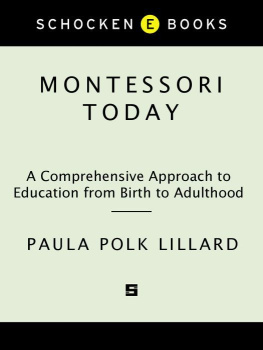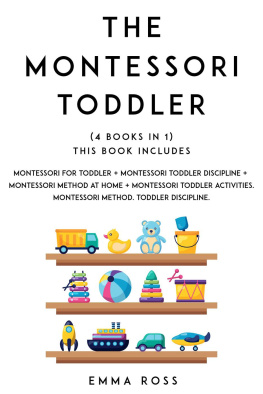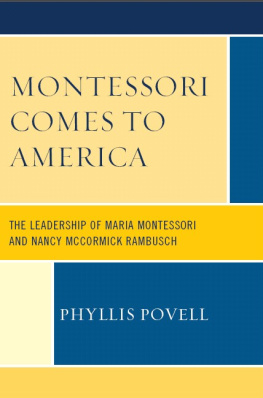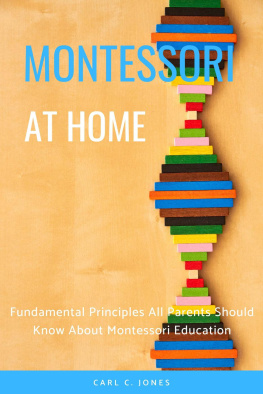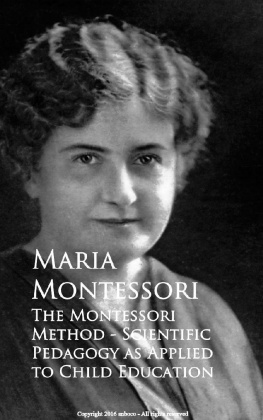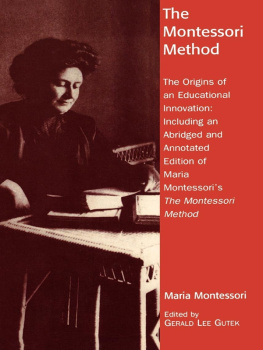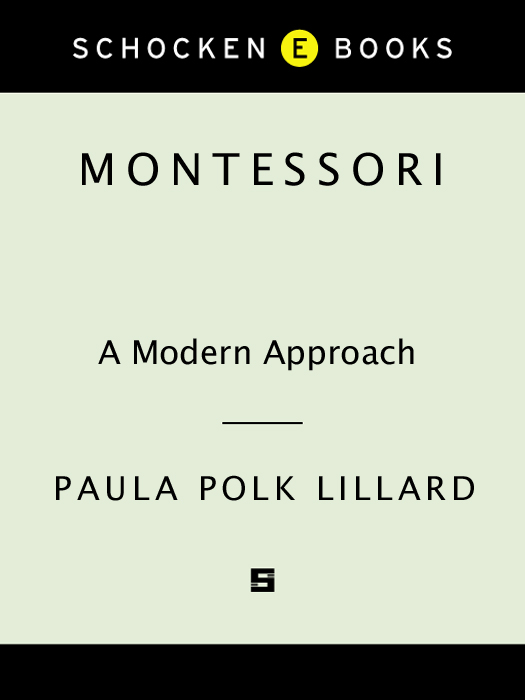Lillard / Montessori: A Modern Approach
ALSO AVAILABLE FROM SCHOCKEN
Montessori Today:
A Comprehensive Approach to Education from Birth to Adulthood
by Paula Polk Lillard
Dr. Montessoris Own Handbook:
A Short Guide to Her Ideas and Materials
by Maria Montessori
The Montessori Method
by Maria Montessori

Copyright 1972 by Schocken Books Inc.
All rights reserved under International and Pan-American Copyright Conventions. Published in the United States by Schocken Books Inc., New York. Distributed by Pantheon Books, a division of Random House, Inc., New York. Originally published by Schocken Books Inc. in 1972.
PHOTOGRAPHIC CREDITS
Richard Meyer: photographs , taken at the Mercy Montessori Center, Cincinnati, Ohio.
James F. Brown: photographs , taken at the Xavier University Montessori Class, Cincinnati, Ohio.
Terry Armor: photographs , taken at the Cincinnati Country Day School, Cincinnati, Ohio.
Library of Congress Catalog Card Number 78-163334
eISBN: 978-0-307-76133-0
v3.1
TO MY HUSBAND, JOHN,
for his encouragement and support, and to our daughters, Lisa, Lynn, Pamela, Angel, and Poppy, who made many sacrifices for mothers paper.
T HIS BOOK is not just a popular introduction in Montessori education. It is also that, of course: a well-chosen and coordinated presentation of its basic principles and techniques, preceded by a historical survey of its vicissitudes in the States and a preface giving a flash of a classroom at work, and ending with some considerations of its present-day value plus a perspective of ongoing research. As such, it offers to any educated person wishing to know whats what a condensed, all-around view of the whole field, based on reliable, well-documented information.
But its particular merit is its use for those working in the field of education and related sciences. No serious person thus engaged will deny the influence of Maria Montessoris ideas on modern thinking about the child and human development in general. The message of this woman must indeed have been forceful and profound to have had this kind of impact without losing its freshness up to the present day.
Mrs. Lillard has succeeded in bringing it over loud and clear for all who care to hear. She has not given in to the temptation of many authors writing on Montessori educationto give their own interpretation of it or to present its fundamental features together with ready-made criticisms. She lets, as it were, Maria Montessori speak for herself. The readers can draw their own conclusions.
Consequently, this book can be recommended as an introduction of Montessoris ideas to all professionals dealing with the human being. Parents and other educators should read it as a matter of course. Its the best in its class.
M. M. M ONTESSORI
July 1973
Preface
I N 1961, a close friend of mine gave me a book to read, entitled Maria Montessori: Her Life and Work, by E. M. Standing. I was most interested in the book because I knew my friend had determined her own children must have a Montessori education if at all possible. I did not remember ever having heard of Montessori before, although after reading Standings book I think I must have read some of her work while majoring in education at Smith College. She was not popular at the time, but Im certain I remember her ideas concerning playpens, childrens sleeping hours, and several other ideas that impressed me and which I had followed in raising my own children.
Standings book on Montessori did not impress me, however. It struck me as outdated, not very well organized, and offensive in its near deification of Montessori. More important, Montessoris description of the children in her schools seemed unrealistic to me. I had been a public school teacher, and I could not reconcile her accounts of childrens behavior with my own experience. I dismissed Montessori as a turn-of-the-century Italian romantic, and felt some concern that my friend who had no background in education had been so impressed.
At this point, William Hopple, Assistant Headmaster of Cincinnati Country Day School, the private school that two of my children attended, visited the Whitby School in Greenwich, Connecticut. This school was founded by Nancy McCormick Rambusch in the late 1950s, and represents the initial re-introduction of Montessori to America. He was so impressed by what he saw that he came back to Cincinnati determined to begin a Montessori class for three- to six-year-olds in his own school.
Because of my respect for his judgment, I decided to take another look at Montessoriparticularly with my three-year-old daughter in mind. I met Hilda Rothschild, the Montessori teacher who was to direct the class, and was favorably impressed by her. When Bill Hopple asked if I would serve as her assistant for the year, I agreed. My husband and I then entered our child in the class, feeling that, if something happened in the classroom we didnt approve of, we would know it immediately and could withdraw her. Like most parents, we are cautious when it comes to our own children!
What followed in the days ahead was beyond any imagining or expectation I could have had. There were sixteen three- and four-year-old children in the class, only four of whom were girls. They had not been pre-selected by the teacher; in fact, she had not seen them until the day school opened. Some of the children had special problems. Perhaps some of the parents who were interested in this class were looking to a new form of education for answers either to their childrens problems or to inadequacies in themselves as parents.
What seemed so amazing to me that fall was the teachers constant reaching out to the children, and the responses she aroused in them. She persistently called them away from aimless, destructive, sometimes chaotic behavior, and toward something in themselves that seemed to pull them together, to bring them into focus, and to free them for a constructive response to their world. Because of the personal integration they achieved, the atmosphere in the classroom was spontaneous, joyful, and purposeful. There was a peace and freedom from tension there that seemed to release the children to live their lives to the fullest.
The ways in which Mrs. Rothschild helped the children to create the unique environment in the classroom particularly impressed me. I should say, first of all, that she is an unusually wise and experienced teacher. Having trained under Dr. Montessori in France and taught in Montessori schools there, she fled to the United States when the Germans invaded France in World War II. In America, she became interested in special education, receiving a masters degree in this field from Syracuse University. She had taught a variety of classes for young children for twenty years before taking a refresher course in Montessori education in the United States, and becoming once again the teacher of a class recognized and defined as Montessori.
Her approach to the children in the classroom could be summed up by one wordrespect. She accorded to them the dignity, trust, and patience that would be given to someone embarked on the most serious of endeavors and who was, at the same time, endowed with the potential and desire to achieve his goal. There is much lip service, of course, paid in traditional education to the concept of respecting young children; yet it was obvious to me that what I was observing was something very different from anything I had seen before. This teacher seemed to have the knack of being inside a childs skin. She absolutely knew how deeply he had been hurt by some slight or how frustrated he felt when he was unable to make his needs known. Because she trusted his ability to tell her what was troubling him, she was constantly in a listening state, No matter how occupied she was with one individual child at a time, she was alert to the others. The antennae were always out. As one person observed after watching her class, Why, that woman has eyes in the back of her head!


